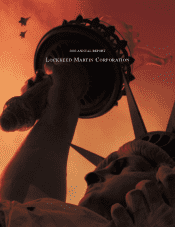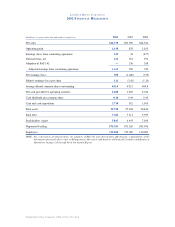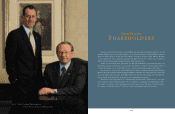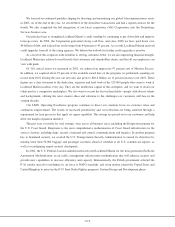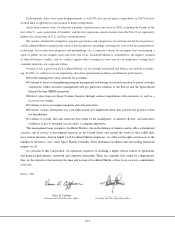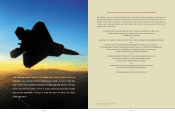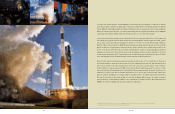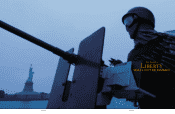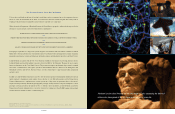Lockheed Martin 2002 Annual Report Download - page 5
Download and view the complete annual report
Please find page 5 of the 2002 Lockheed Martin annual report below. You can navigate through the pages in the report by either clicking on the pages listed below, or by using the keyword search tool below to find specific information within the annual report.
We focused on continued portfolio shaping by divesting and monetizing our global telecommunications assets
in 2002. As of the end of the year, we closed three of the divestiture transactions and had a signed contract for the
fourth. We also completed the full integration of our latest acquisition, OAO Corporation, into the Technology
Services business area.
Our plan has been to strengthen Lockheed Martin’s credit standing by continuing to pay down debt and improve
leverage ratios. In 2002, the Corporation generated strong cash flow, and since 2000 we have paid down over
$4 billion of debt, and reduced our net leverage from 64 percent to 45 percent. As a result, Lockheed Martin received
credit upgrades from all of the rating agencies. We believe the outlook for further credit upgrades is positive.
As a result of this corporate-wide attention to serving customers better, we are also improving financial strength.
Lockheed Martin has achieved overall results that customers and shareholders desire, and that all our employees can
view with pride.
Of 318 critical events we measured in 2002, we achieved an impressive 97 percent rate of Mission Success.
In addition, we captured about 95 percent of the available award fees on the programs we performed, equaling our
record from 2001. During the year our net sales also grew to $26.6 billion, an 11 percent increase over 2001. These
figures are a clear testament to the dedication, expertise and hard work of the 125,000 people who come to work at
Lockheed Martin facilities every day. They are the intellectual capital of this enterprise, and we want to retain our
talent pool in a competitive marketplace. We also want to recruit the best in their fields—people with diverse talents
and backgrounds, offering the most creative ideas and solutions to the challenges our customers will face in the
coming decades.
Our LM21 Operating Excellence program continues to direct our common focus on customer value and
continuous improvement. The results of increased productivity and cost reduction are being achieved through a
requirement for lean processes that apply six sigma capability. The savings are passed on to our customers and help
drive our margin expansion initiative.
The past year is notable for vital strategic wins across all business areas, including the Deepwater program for
the U.S. Coast Guard. Deepwater is the most comprehensive modernization of Coast Guard infrastructure in the
service’s history, including ships, aircraft, command and control, communications and logistics. In another program
key to homeland security, we assisted the U.S. Transportation Security Administration to exceed its objectives by
training more than 50,000 baggage and passenger screeners ahead of schedule at all U.S. commercial airports, as
well as reconfiguring airport security checkpoints.
In 2002, the U.S. Federal Aviation Administration selected Lockheed Martin for the next-generation En Route
Automation Modernization, an air traffic management infrastructure modernization that will enhance security and
provide new capabilities to increase efficiency and capacity. Internationally, the Polish government selected the
F-16 combat aircraft to modernize its air force to NATO standards, and seven nations joined the United States and
United Kingdom to invest in the F-35 Joint Strike Fighter program’s System Design and Development phase.
FOUR

